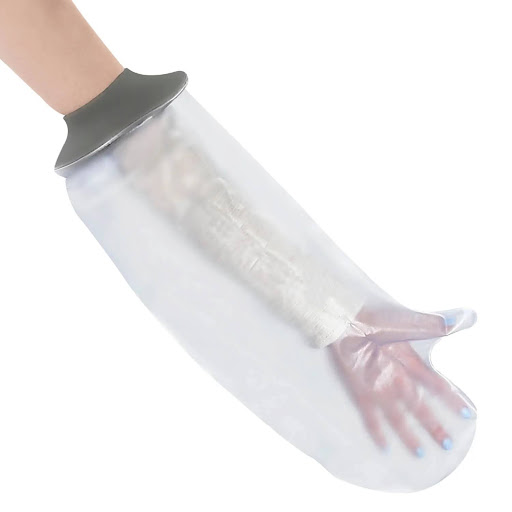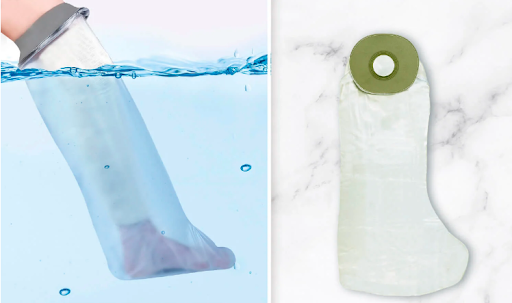There’s a common challenge faced by individuals sporting a cast or dressing: maintaining proper hygiene while managing the limitations imposed by the cast. Many worry about keeping their injury dry while still being able to shower or bathe comfortably. This article provides valuable insights and practical tips to navigate this situation effectively and safely.
Protecting Your Cast from Water
First and foremost, it is crucial to protect your cast from water to prevent it from becoming damaged, which can lead to skin issues or even delay recovery. Utilizing protective covers is an important strategy. A high-quality product like the Adult Arm Waterproof Cast Cover for Shower & Bath is specifically designed to keep your cast dry while you enjoy your bath or shower. Made with stretchy neoprene and a PVC body, it offers a secure fit for maximum protection.
Ensuring a Proper Seal for Cast Covers
When using a cast cover, it’s important to ensure that it is sealed properly. Before stepping into the shower or tub, double-check that the cover is fitted snugly around your arm to prevent any water from seeping in. A well-sealed cover not only guards against water but also allows you to bathe with confidence.
Adjusting Your Bathing Routine
If you prefer a bath, consider using a shallow tub where you can adjust the water level, keeping your injured arm elevated and safe from water exposure. Alternatively, a sponge bath can be a viable solution. Use a damp sponge to gently wash the unaffected parts of your body while keeping the cast-covered area completely dry. Baby wipes can also serve as a convenient tool for cleaning, especially if it’s challenging to get your entire body wet.
Preparing for a Safe Shower
For showering, setting up before you start is key. Ensure all necessary toiletries are within reach to minimize the need for movements that could risk getting your cast wet. Install a shower chair if you are feeling unsteady, as sitting can help reduce the chance of slips or falls while being mindful of your injury. Additionally, using non-slip mats in the shower can enhance safety.
Timing Your Showers
Another helpful tip is to time your showers strategically. Sometimes, having a quick shower is better than a relaxed soak, as it reduces the time your cast is exposed to the risk of water. Aim for shorter showers, which can also help prevent fatigue if you are adjusting to new limitations post-injury.
Drying Your Cast After Bathing
Finally, prioritize drying your cast as soon as you finish showering or bathing. Pat the cast area gently with a towel and allow it to air dry in a well-ventilated area. This not only helps eliminate moisture but also keeps the area odor-free, which is important for managing hygiene effectively.
FAQs
- Can I shower with a cast on?
Yes, you can shower with a cast on, but it is crucial to use a waterproof cast cover to keep the cast dry and avoid any water exposure that could damage the cast or cause skin irritation. - What should I do if water gets into my cast?
If water gets into your cast, try to dry it as quickly as possible. Use a hairdryer on a cool setting to help evaporate the moisture, or consult with your healthcare provider for further advice. - How can I keep my cast dry during a bath?
To keep your cast dry during a bath, use a waterproof cast cover and consider taking a shallow bath where you can keep the casted area elevated and away from the water. Alternatively, sponge baths are a good option to avoid any water exposure to the cast.
Key Takeaways
- Use Waterproof Cast Covers: Protecting your cast with a waterproof cover is essential to prevent water damage and maintain proper hygiene.
- Adjust Your Bathing Routine: Consider alternative methods like sponge baths or quick showers to minimize the risk of getting your cast wet.
- Prioritize Safety: Prepare your bathing area with non-slip mats and a shower chair if necessary, and always ensure toiletries are within easy reach to avoid unnecessary movements.
Conclusion: Hygiene and Recovery Go Hand in Hand
Maintaining hygiene with a cast can be challenging, but with a few precautions and helpful tools like waterproof cast covers, it can be managed safely and comfortably. Taking the time to plan your bathing or showering routine will contribute significantly to your recovery process while ensuring you stay fresh and clean.


